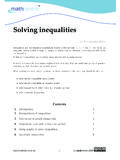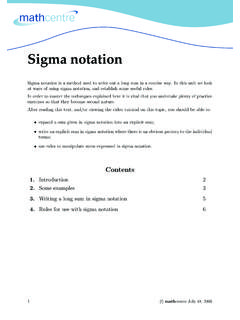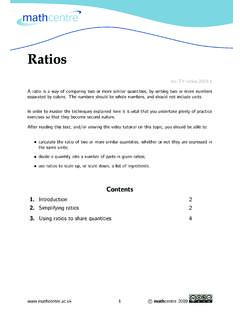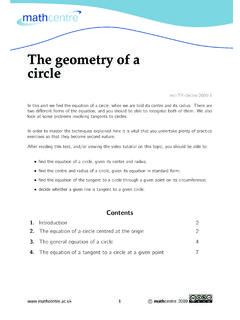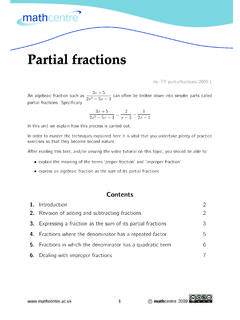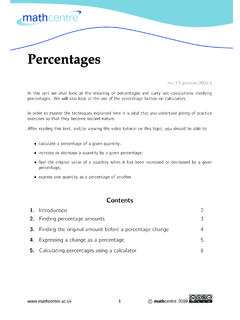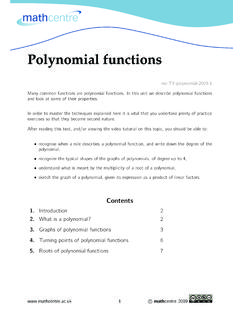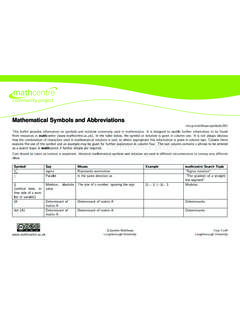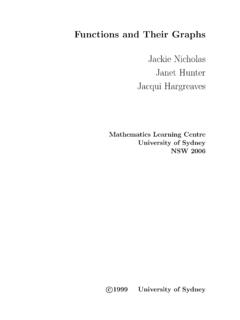Transcription of Solving inequalities - mathcentre.ac.uk
1 Solving inequalitiesmc-TY- inequalities -2009-1 inequalities are mathematical expressions involving the symbols>,<, and . To solve aninequality means to find a range, or ranges, of values that an unknownxcan take and still satisfythe this unit inequalities are solved by using algebra and by using order to master the techniques explained here it is vital that you undertake plenty of practiceexercises so that they become second reading this text, and/or viewing the video tutorial on this topic, you should be able to: solve simple inequalities using algebra solve simple inequalities by drawing graphs solve inequalities in which there is a modulus symbol solve quadratic of some simple used with a modulus graphs to solve mathcentre 20091. IntroductionThe expression5x 4>2x+ 3looks like an equation but with the equals sign replaced by anarrowhead.
2 It is an example of denotes that the part on the left,5x 4, is greater than the part on the right,2x+ 3. Wewill be interested in finding the values ofxfor which the inequality is use four symbols to denote inequalities :Key Point>is greater than is greater than or equal to<is less than is less than or equal toNotice that the arrowhead always points to the smaller Manipulation of inequalitiesInequalities can be manipulated like equations and follow very similar rules, but there is oneimportant you add the same number to both sides of an inequality, the inequality remains you subtract the same number from both sides of the inequality, the inequality remains you multiply or divide both sides of an inequality by the samepositivenumber, the inequalityremains if you multiply or divide both sides of an inequality by a negative number, the inequality isno longer true.
3 In fact, the inequality becomes reversed. This is quite easy to see because wecan write that4>2. But if we multiply both sides of this inequality by 1, we get 4> 2,which is not true. We have to reverse the inequality, giving 4< 2in order for it to be leads to difficulties when dealing with variables, because a variable can be either positive ornegative. Consider the inequalityx2> xIt looks as though we might be able to divide both sides byxto givex > mathcentre 2009 But, in fact, we cannot do this. The two inequalitiesx2> xandx >1are not the same. Thisis because in the inequalityx >1,xis clearly greater than 1. But in the inequalityx2> xwehave to take into account the possibility thatxis negative, since ifxis negative,x2(which mustbe positive or zero) is always greater thanx.
4 In fact the complete solution of this inequality isx >1orx <0. The second part of the solution must be true since ifxis negative,x2is alwaysgreater thanx. We will see in this unit how inequalities like this are solved. Great care has to betaken when Solving inequalities to make sure you do not multiply or divide by a negative numberby accident. For examplesaying thatx > y, implies thatx2> y2only ifxandyare can see the necessity of the condition that bothxandyare positive by consideringx= 1andy= 10. Sincexis positive andynegative it follows thatx > y; butx2= 1andy2= 100and soy2> PointWhen Solving an inequality: you can add the same quantity to each side you can subtract the same quantity from each side you can multiply or divide each side by the samepositivequantityIf you multiply or divide each side by a negative quantity, the inequality symbol must be Solving some simple inequalitiesSuppose we want to solve the inequalityx+ 3> can solve this by subtracting 3 from both sides:x+ 3>2x > 1So the solution isx > 1.
5 This means that any value ofxgreater than 1satisfiesx+ 3> can be represented on a number line such as thatshown in Figure 1. The solid lineshows the range of values thatxcan take. We put an open circle at 1to show that althoughthe solid line goes from 1,xcannot actually equal 3 4 5 6-1-2-3-4-5 Figure 1. A number line showingx > mathcentre 2009 ExampleSuppose we wish to solve the inequality4x+ 6>3x+ we subtract 6 from both sides to give4x >3x+ 1 Now we subtract3xfrom both sides:x >1 This is the solution. It can be represented on the number lineas shown in Figure 3 4 5 6-1-2-3-4-5 Figure 2. A number line showingx > we wish to solve3x 5 3 start by adding 5 to both sides:3x 8 xThen addxto both sides to give4x 8 Finally dividing both sides by 4 givesx 2 This is shown on the number line in Figure 3.
6 The closed circledenotes thatxcan actually 3 4 5 6-1-2-3-4-5 Figure 3. A number line showingx we wish to solve the inequality 2x > order to solve this we are going to divide both sides by 2, and we need to remember thatbecause we are dividing by a negative number we must reverse the < 2 There is often more than one way to solve an inequality. We aregoing to solve this one againby using a different method. Starting with 2x >4we could add2xto both sides to give0>4 + 2xThen we could subtract 4 from both sides giving 4>2xand finally dividing both sides by 2 gives 2> xSaying thatxis less that 2is the same as saying 2is greater thanx, so both forms mathcentre 2009 Exercises 11. Draw a number line representation of each of the followinginequalities:a)x >3b)x 2c) 1< x 2d)x 5e)4 x <9h) 6< x <22.
7 Give the inequality which produces the range shown in eachof the figures 3-1-2-3-4-5012 3 4 5 6-1-2-3-4-5-6-7-8012 3 4 5 6-1-2-3-4-5012 3 4 5 6-1-2-3-4-5012 3 4 5 6-1-2-3-4-5a)b)c)d)e)3. Solve the following inequalitiesa)3x 9b)2x+ 3 15c) 3x <12d)2 3x < 4e)1 + 5x <19f)11 2x >5g)5x+ 3>3x+ 1h)12 3x <4x 24. inequalities used with a modulus symbolInequalities often appear in conjunction with the modulus,or absolute value symbol||, forexample, in a statement such as|x|<2 Recall that the modulus of a number is simply its magnitude, or absolute value , regardless of itssign. So|2|= 2and| 2|= 2 Returning to|x|<2, if the absolute value ofxis less than 2, then this means thatxmust liebetween 2 and 2. We can write this as 2< x <2. This range of values is shown on thenumber line in Figure 3 4 5 6-1-2-3-4-5 Figure 4.
8 A number line showing 2< x < mathcentre 2009 Observe that|x|also measures the distance of a point on the number line from the origin. Forexample, both the points2and 2are distance 2 units from O, and so they have the sameabsolute value , 2. If we write|x|<2we mean all points a distance less than 2 units from these are the points in the interval 2< x < ,|x 4|<2represents all points whose distance from the point4is less than 2. Theseare the points in the interval2< x < we wish to solve the inequality|x| |x| 5this means that the absolute value ofxmust be greater than or equal to 5. Thismeans thatxcan be greater than or equal to 5, or can be less than or equal to 5. We writex 5 orx 5 This range of values is shown on the number line in Figure 3 4 5 6-1-2-3-4-5 Figure 5.
9 A number line showing|x| next example is more we wish to solve|x 4|<3 The modulus sign means that the absolute value ofx 4is less than 3. This means that 3< x 4<3 This is what is called a double inequality. We must treat it astwo separate the left we get 3< x 4and by adding 4 to both sides we obtain1< the right we havex 4<3, and by adding 4 to both sides we getx < can write these solutions together as1< x <7and this range of values ofxis illustrated on the number line in Figure 3 4 5 6-17 8 Figure 6. A number line showing1< x < mathcentre 2009 ExampleSuppose we wish to solve|5x 8| means 12 5x 8 12and again we have a double the left: 12 5x 8. Adding 8 to both sides: 4 5x, and dividing by 5 gives, 45 the right:5x 8 12. Adding 8 to both sides:5x 20.
10 Dividing by 5 givesx these results together gives the solution 45 x 4 This range of values is shown on the number line in Figure 3 4 5 6-1-2-3-4-5 Figure 7. A number line showing the values ofxfor which|5x 8| 2 Solve the following inequalitiesa)|x| 3b)|x|>6c)|x 4| 3d)|x 2| 5e)|x+ 1|<3f)|x+ 4| 2g)|3 x|>1h)|x+ 1| 05. Using graphs to solve inequalitiesInequalities can be solved very easily using graphs, and if you are in any way unsure about thealgebra, it would be a good idea to do a graph to check. Let us see how this we wish to solve2x+ 3< inequality could be solved very easily doing algebra, but it makes a good graphical we sketch a graph ofy= 2x+ 3as shown in Figure 8. Note that it is a straight line. Ithas a slope of 2 and an intercept on theyaxis of 2 3-33xyFigure 8.
